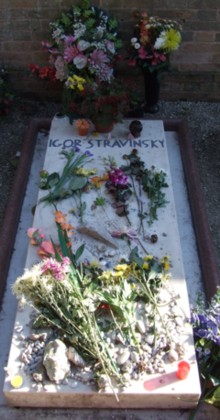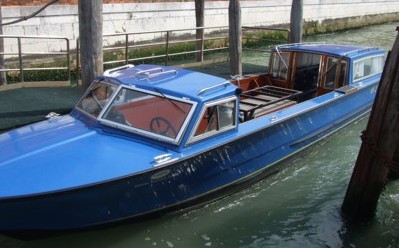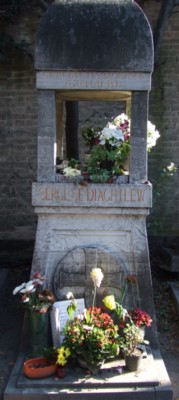The island of San Michele, located in the lagoon close to Venice, has been the city’s cemetery (cimitero) since the early nineteenth century. As Venice is an island community, it’s not really surprising that its graveyard is also an island, although the notion may seem odd at first. Formerly two islands, which are now joined together, the Isola di San Michele (St. Michael) is dedicated to the dead, and is occupied only by churches and by long ranks of tombs.
Italian cemeteries
Cemeteries in Italy are not usually tourist destinations. They are commonly located outside towns, with both location and appearance likely to strike an unfamiliar note with overseas visitors. Remains are often interred in high rows of tombs, resembling chests of drawers. Photographs of the deceased are a common feature and – once you get used to them – are touching memorials to couples in their Sunday best, and haircuts through the twentieth century. Italian families make pilgrimages to these graveyards, heading there en masse on the 1st and 2nd November to lay flowers, which are often sold at stalls outside the cemetery gates. (Visitors should note that here in Italy chrysanthemums are flowers for the dead, and make highly inappropriate gifts for the living). In Venice on these dates there are special additional ferry services to the cemetery.
Tombs and memorials of eminent historical figures are usually more easy of access, and tourists will find them situated in churches and basilicas. There are a few exceptions, however, particularly for non-Catholic communities – Keats and other Protestants are buried in the lovely Protestant Cemetery in Rome, and in Venice too, travellers will find some big names at rest in the non-Catholic sections of San Michele.
Although the cemetery on San Michele is prepared for visitors and does contain signs to the areas containing ‘famous’ graves, it should be remembered that most of the tombs here are very recent and visited by bereaved families. Visitors should follow the usual rules of decorum and modest dress which apply in Italian churches.

San Michele: The Church and Cappella Emiliani
There are two churches on the island, the large San Michele in Isola and the smaller San Cristoforo. San Michele was designed by Mauro Codussi in the 1460s and was one of the earliest Renaissance churches in Venice, with a white facade of Istrian marble overlooking the lagoon. The church’s opening hours are restricted, and may be shortened still further if services are taking place. It’s worth timing your visit accordingly, not just to see the church, but also for the chance to view the interior of the lovely adjoining Cappella Emiliani, which can be admired through a doorway at the back of the church. This chapel, perched on the edge of the lagoon, can also be admired from the flood-prone terrace outside, and from passing ferries. Seaweed on the paving around it demonstrates how dangerous its waterside position is, although metal barriers protect it from some of the wash from passing boats. Recently the building was restored by the British organisation Venice in Peril, and now it gleams like new.

The graves
The cemetery is divided up into many sections, and without a map it is a very confusing site. Signs will conduct visitors to the Orthodox and Protestant cemeteries; other sections are harder to locate. Wandering around can be an interesting and touching experience. One area is given over to the humble memorials of nuns and the sometimes less humble graves of priests. According to the Time Out guidebook, there is a section for gondoliers, although we haven’t yet found this. Many of the recent graves seem very kitsch and strange to foreign eyes – some decorated with sad photographs of the dead and with ornaments, doilies and toys.
The Orthodox area is a charming walled garden which traps late sunlight and crawls with lizards. Against the far wall visitors will find the tombs of Sergei Diaghilev and Igor Stravinsky, festooned with the offerings of ballet and music-lovers. Other graves around the walls are also fascinating, bearing testament to the lives of exiles in Venice of days gone by – Russian princesses and counts, for example. Ezra Pound is buried in the Protestant section – his tomb is hard to spot; it’s to the left of the central path and resembles a flowerbed.
Space is limited on the island, although an enlargement is under way, and burials are squeezed in tightly. Nowadays dead Venetians are only guaranteed a few years of rest on San Michele. After a period of around ten years, remains are exhumed and stored in an ossuary. Discreet noticeboards around the entrance list the timetable for exhumations.

Get there
San Michele is off the northern shore of Venice, and can be distinguished by its high walls and cypresses. The island is on the route of the regular vaporetto services 41 and 42 to Murano (a combined trip can fit in well with sightseeing). The stop is called Cimitero and is one stop from the Fondamente Nove. The church of San Michele is closed at lunchtimes.
Other cemeteries
Venice also has a historic Jewish cemetery, which is situated on the Lido and be visited in the summer on once-weekly tours organised by the Museo Ebraico. An earlier Protestant cemetery was also on the Lido, but it was destroyed during the construction of a small airfield. In her book about Venice, Jan Morris describes uncovering the rehoused gravestones, and stumbling across that of eminent British Consul (and patron of Canaletto) Joseph Smith. His tombstone has since been salvaged; it is now on the wall of the Anglican Church in Dorsoduro.
> More Venice tourist attractions
On this site
Useful external links
